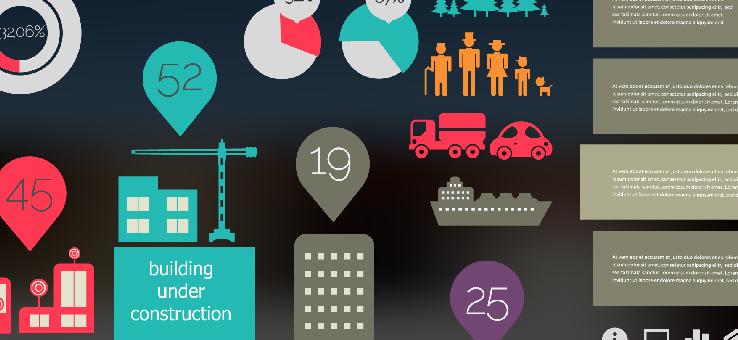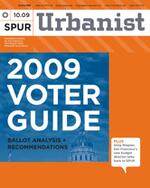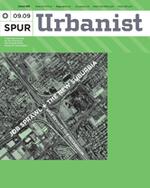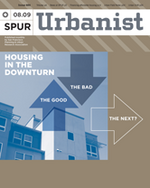
This Week at SPUR: World Renowned Climate Scientist Ken Caldeira
News / SPUR is thrilled to welcome Ken Caldeira, head of the Carnegie Institution for Science's Department of Global Ecology at Stanford University, to the Urban Center for a lunchtime forum. The details: Wednesday, October 28, 12:30 - 1:30 p.m. Free for SPUR members. General admission is $5. Location: SPUR Urban Center, 654 Mission St. (between New Montgomery & Third). Renowned for his groundbreaking research on…
SF Battles the Yogi Berra Parking Problem
News / Yogi Berra once posited about a restaurant suffering a perceived decline, "Nobody goes there anymore -- it's too crowded." San Francisco parking faces the same dilemma: high parking occupancy and low turnover make parking in San Francisco a headache as drivers are forced waste upwards of 45 minutes orbiting for a space, adding to traffic and burning gasoline. To combat this problem, the SFMTA is…
Lawn Chairs in Times Square
News / At a SPUR lunchtime forum yesterday, President of the Times Square Alliance (TSA) Tim Tompkins spoke about the evolution of Times Square over the past several decades. For decades, New York fought the uphill battle of making Times Square cleaner, safer, and more inviting, only to find themselves with a new set of challenges: the area has become so popular, particularly with tourists, that the…
Planning on the Edge: A Conversation with Six Planning Directors
News / Join us on Wednesday, November 4 at City Hall for this special event, featuring planning directors from six cities, co-sponsored by SPUR and the San Francisco Planning Department. The evening's lineup includes: BILL ANDERSON from San Diego SUSAN ANDERSON from Portland AMANDA BURDEN from New York City JOHN RAHAIM from San Francisco DIANE SUGIMURA from Seattle BRENT TODERIAN from Vancouver This event starts at 6…
Planning Historians Unite! (This Weekend!)
News / It's not too late to catch some sessions at the National Conference in Planning History taking place at the Oakland Marriott this weekend. Organized by the Society for American City and Regional Planning History, many of the panels and tours are focused on the Bay Area, as well as their Sunday tours, which include "Historical Development and Ethnic Change in Oakland," "Urban Renewal in San…
Invade the Armory
News / SPUR members toured the Mission Armory, the 200,000 square foot Moorish Castle Reproduction completed in 1914. From it's completion until 1976, the Armory was used as a National Guard facility, and later joined the National Register of Historic Places. The drill court, spanning nearly an acre, served not only as a military training facility, but also as boxing arena, and hall for social events for…
Sea Level to Rise 5 Meters in 300 Years
News / A climate conference in Oxford concluded last week that whatever we can do to slow carbon emissions, it won't be enough to stop accelerated sea level rise. In fact, a German scientist who's widely regarded as one of the world's foremost experts on sea level rise, said his best guess was 1 meter this century (a lowball figure compared to the latest projections for California)…
Growing on Our Buildings
News / Some of the first calculations of the benefits of green roofs are coming back and they're even better than expected: replacing typical roofing materials with plants across a city the size of Detroit would be the equivalent of removing the pollution of 10,000 SUVs in a year. This study is the first to measure the amount of carbon that could be captured by the extensive…
Our Great Boulevard
News / Today was the second day of the six-week Better Market Street Project trial number one, which diverts cars headed north off of Market Street at 8th and 6th avenues, in an attempt to reduce traffic on the oft-clogged street. What a transformation! The morning bicycle commute has become a breeze and we hope will encourage more workers to choose their two-wheeled vehicle. The Better Merket…
Burning Man Takes on the City
News / Two weeks ago the great parade of cars covered in the white desert dust returned from Black Rock City, Nevada, Burning Man's annual week-long home. Along with the many tales, burners brought back news of next year's theme: Metropolis: the life of cities. Besides celebrating Black Rock City's own urban elements--a population of 40-50,000 people with (temporary) homes on lots within blocks; a system of…
Solar = 'Peaker' Power, without the EJ Issues
News / This summer, somewhere in California, the state Energy Commission denied an application for a new urban natural gas-burning power plant, citing that urban solar (PV) might be a better alternative. The CEC said that new "peakers" were not obviously the most cost-effective or environmentally preferable option to close that city's energy reliability gap. For years, SPUR and a loose coalition of environmental advocates, led by…
Music, Dancing, Urbanists at 2009 PARK(ing) Day
News / Last Friday, we teamed up with the San Francisco Great Streets Project and the San Francisco Bicycle Coalition to participate in 2009 PARK(ing) Day, an event-cum-social movement started by Rebar in 2005. Before the big day, architect and SFBC volunteer Riyad Ghannam spent countless hours in the Urban Center's basement designing and building wooden platforms to create a seamless transition between the sidewalk and…
NY Times Columnist Allison Arieff Blogs about P2P (and Land-Lending in a Soft Economy)
News / New York Times columnist Allison Arieff penned a piece yesterday on the temporary parks and open spaces sprouting up in San Francisco and New York City--and the opportunity for land owners (in this soft economy) to lend their empty lots to grassroots greeners. This image, from Arieff's column, shows the site of one of San Francisco's newest temporary plaza at the intersection of…
What GOOD Design can do for San Francisco
News / Last month, AIA San Francisco, CEOs for Cities, GOOD Magazine and SPUR issued a "call for problems" to a handful of city leaders, and asked six up-and-coming designers to develop responses and present them at an evening forum later this month. The challenges we got ranged from improving public schools, to designing a more welcoming storefront for the Ferry Building, to coming up with…
Gabriel Metcalf Shares Thoughts on SPUR's History, Nonprofit Management and Social Change
News / Maureen Futtner of the San Francisco Examiner asks SPUR Executive Director Gabriel Metcalf about the trajectory of his career (from SPUR intern to Executive Director), the role of optimisim in affecting social change and his thoughts on what makes a great city leader.
Earthquake Resilience, One Building at a Time
News / Twenty years after Loma Prieta, are we better prepared for our next big earthquake? A new website takes a grassroots approach to the question.
Moving Cooler
News / Transportation-related greenhouse gas (GHG) emissions are the fastest growing source of emissions in the U.S., and are currently responsible for almost 30% of the nation's total GHG output. A new ULI report, Moving Cooler, presents different strategies for making our transportation systems more sustainable. It proposes nine categories for improvement, including pricing/taxes, land use and smart growth, transit improvements, ridesharing, intelligent systems, and more…


